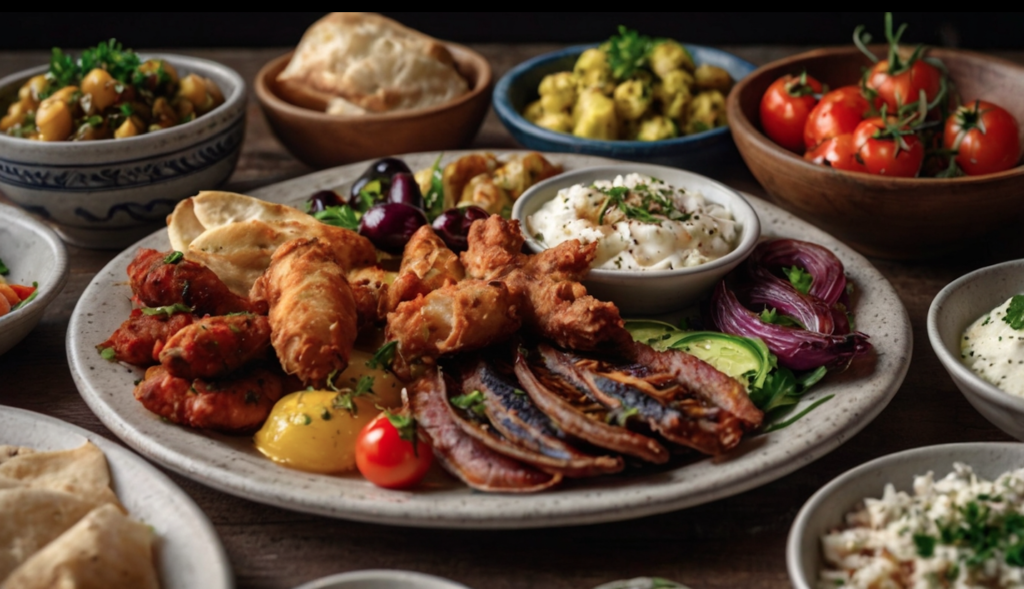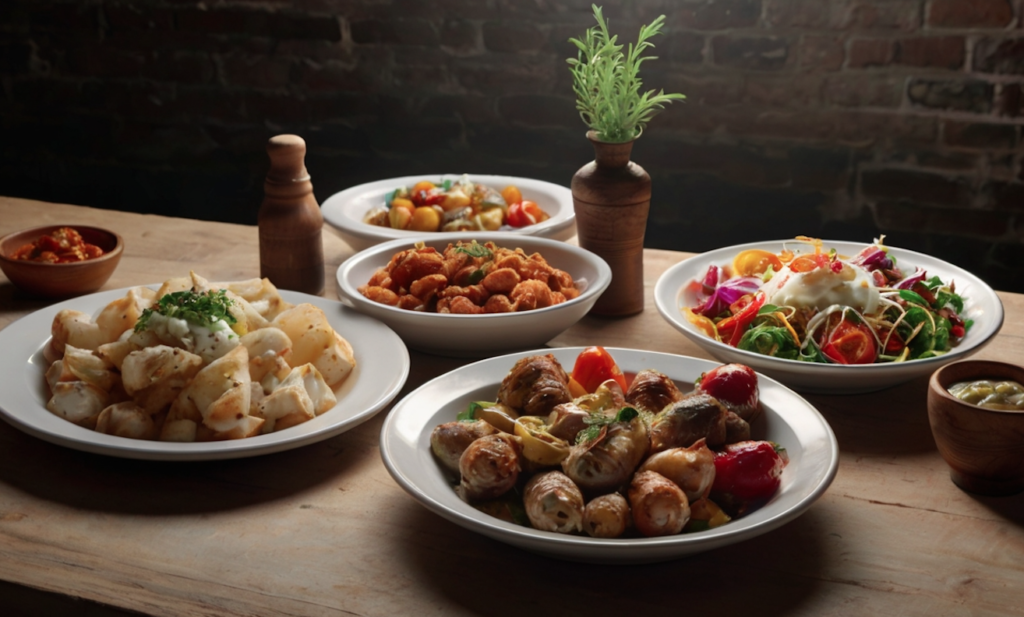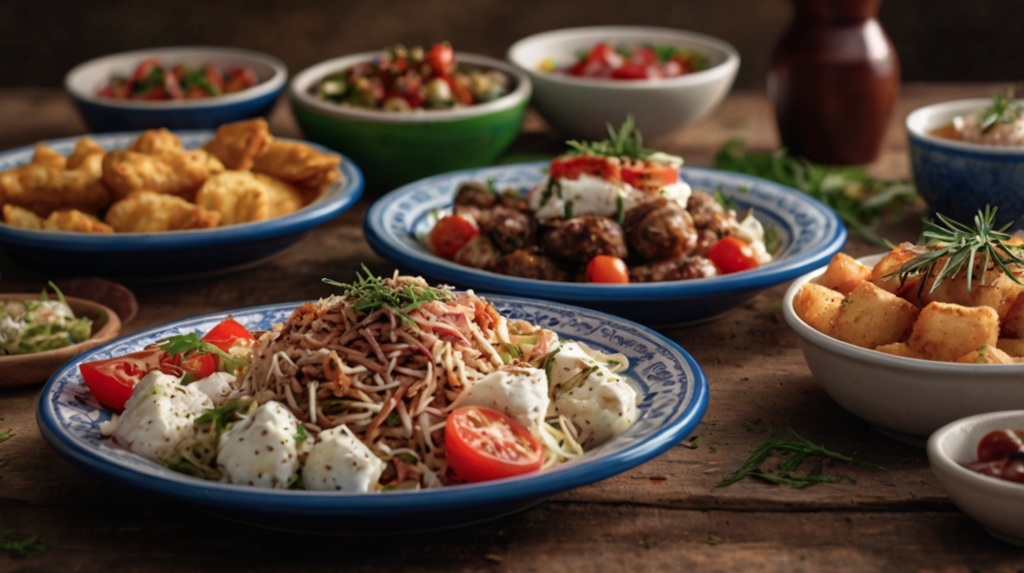Hi there, neighbors! Andreas here. Since moving to America from sunny Cyprus, I’ve had the pleasure of meeting many of you wonderful folks. We’ve shared stories over backyard barbecues and potlucks, and I’ve learned so much about your traditions. Now, I’d love to return the favor and introduce you all to a cornerstone of Cypriot culture: the art of meze.
Meze (pronounced meh-zeh) isn’t just a meal; it’s a way of life. It’s a celebration of sharing, good company, and of course, delicious food! Over the next few sections, I’ll take you on a culinary journey through the world of meze, explaining its history, the symphony of flavors that make it so special, and some tips for recreating the magic of a meze experience right here in your own homes.
A Culinary Journey: The History and Evolution of Meze
Food plays a central role in Cypriot life, and meze is no exception. Its roots stretch back to ancient Greece, where the concept of “trapeza” – small plates shared amongst friends – was a common dining practice. Over time, influences from neighboring cultures like the Ottomans and the Middle East further enriched Cypriot cuisine.
Meze evolved from a simple snack to a multi-course affair, often served at tavernas (traditional restaurants) in the evenings. These lively gatherings, filled with laughter and conversation, are a cherished part of Cypriot social life. While there can be regional variations in meze across the island, the core concept remains the same – a delicious and social way to enjoy an array of flavors.

The Heart of the Meze: A Symphony of Flavors
Imagine a table overflowing with a dazzling array of small plates, each showcasing a unique taste and texture. That’s the beauty of a meze spread! There’s no rigid menu, but a typical meze follows a delightful flow:
- Cold Starters (mezedes): These kick off the meze experience, refreshing your palate and whetting your appetite. A classic meze might feature:
- Horiatiki (Village Salad): A vibrant combination of chopped tomatoes, cucumbers, onions, olives, and the salty tang of feta cheese.
- Taramasalata: This creamy dip, made with whipped cod roe, olive oil, and lemon juice, adds a touch of the sea to the table.
- Hummus: A beloved staple across the Mediterranean, this chickpea dip, flavored with tahini and spices, is perfect for scooping up with warm pita bread.
- Dolmades: Delicate grape or vine leaves, meticulously stuffed with rice, herbs, and sometimes minced meat, offer a burst of flavor in every bite.
These are just a few examples, and the possibilities are endless. Think roasted vegetables drizzled with olive oil, marinated mushrooms, or spicy dips like melitzanosalata (roasted eggplant dip). The key is variety, ensuring a delightful progression of tastes.
Once your taste buds are tantalized by the cold starters, it’s time to introduce some heat:
- Hot Dishes (psatika): These savory delights bring warmth and complexity to the meze. Here are some popular options:
- Halloumi: This hero of Cypriot cuisine is a semi-hard brined cheese that can be grilled, fried, or even eaten fresh. Its salty flavor pairs perfectly with other elements of the meze.
- Sheftalia: Get ready for these juicy Cypriot sausages! Made with minced pork or lamb and a blend of spices, they are typically grilled on skewers for a smoky and satisfying flavor.
- Loukanika: Another sausage option, loukanika boasts a distinct flavor profile thanks to coriander and orange zest. These are also grilled, adding another layer of texture to the hot dishes.
- Calamari: For seafood lovers, fried or grilled squid is a delightful addition to the meze. Its mild flavor and versatility make it a crowd-pleaser.
Remember, this is just a glimpse into the vast world of meze hot dishes. Grilled vegetables like zucchini and eggplant, Cypriot meatballs (koupepia), and oven-baked lamb are just some of the other delicious options you might encounter.
As you can see, a meze is more than just a collection of dishes; it’s a symphony of flavors, textures, and culinary traditions.

The Art of Sharing: Meze Etiquette
Now that you’ve envisioned the visual and flavorful feast of a meze spread, let’s talk about how Meze is all about sharing and building connections. There are no individual plates; instead, everyone gathers around a table overflowing with small dishes, reaching out and trying a bit of everything. It’s a chance to converse, laugh, and savor the company of loved ones and friends.
Here are some key pointers to keep in mind for an authentic meze experience:
- Siga-siga (Slowly, Slowly): There’s no rush! Meze is meant to be enjoyed at a leisurely pace. Savor each bite, chat with your companions, and let the flavors linger.
- Table Manners: While Cypriots are known for their warm hospitality, there are some basic table manners to keep in mind. Use serving utensils whenever possible to avoid digging directly into communal plates.
- Second Helpings: Offering a second helping is a sign of hospitality in Cypriot culture. So don’t be shy – if you see someone enjoying a particular dish, encourage them to have more! Of course, politeness goes both ways – don’t feel pressured to finish everything on the table.
Remember, meze is all about creating a relaxed and enjoyable atmosphere. The focus is on good company, delicious food, and sharing a taste of Cypriot culture.
In the next section, I’ll share some tips for creating your own meze experience at home, so you can bring the flavors and joy of Cypriot cuisine to your own backyard!
Creating Your Own Meze Experience: Tips and Tricks for a Home Meze
Missing the vibrant atmosphere of a Cypriot taverna doesn’t mean you can’t enjoy a delightful meze experience right in your own home! Here are some tips to help you recreate the magic:
- Start Small: Don’t overwhelm yourself – for a casual gathering, begin with a selection of 3-5 cold and hot dishes. You can always expand your repertoire as you become more comfortable hosting meze nights.
- Variety is Key: Remember, the beauty of meze lies in the diversity of flavors and textures. Aim for a selection that offers a contrasting mix: creamy dips like hummus alongside the salty tang of halloumi, refreshing salads balanced by the smoky aroma of grilled sausages.
- Presentation Matters: Take a moment to arrange your meze dishes on platters or bowls. A visually appealing spread adds to the overall enjoyment of the experience. Think about using colorful ingredients like fresh herbs or cherry tomatoes to create a vibrant display.
Let’s Talk Food:
Here are some pointers when choosing dishes for your home meze:
- Cold Starters: Horiatiki salad, taramasalata, and hummus are always crowd-pleasers. You can also explore vegetarian options like roasted red peppers with garlic or marinated artichoke hearts.
- Hot Dishes: Halloumi is a must-have, and you can grill it alongside vegetables like zucchini and eggplant. If you’re feeling adventurous, try making your own sheftalia or loukanika – there are many online recipes available. For a seafood option, consider pan-fried calamari or grilled shrimp. Remember, these are just suggestions – feel free to get creative and experiment with flavors you and your guests enjoy.
Beyond the Food:
While the food is a central part of the meze experience, don’t forget the ambiance! Put on some lively Greek or Cypriot music to set the mood. Light some candles and use colorful tablecloths to create a festive atmosphere. Most importantly, relax, enjoy the company, and embrace the spirit of sharing that defines meze.
Pairing Meze with Wine:
Cypriot wines are a perfect complement to a meze spread. For lighter starters, consider a crisp white wine like a Xynisteri. Red meat dishes pair well with a bolder red like a Mavrokalamatis. Of course, feel free to choose your favorite beverages, whether it’s wine, beer, or even traditional Cypriot coffee.
The Final Touch:
Don’t forget dessert! While not a traditional part of a meze, a light and refreshing option like fresh fruit or a slice of baklava can be a delightful way to end the evening.
By following these tips, you’re well on your way to hosting a memorable meze experience at home. So, gather your friends and family, fire up the grill, and get ready to embark on a delicious journey through Cypriot cuisine!
Conclusion: A Taste of Cyprus on Your Doorstep
Cypriot cuisine, with its emphasis on fresh ingredients, bold flavors, and the joy of sharing, offers a delightful culinary adventure. Meze, the cornerstone of Cypriot dining, is more than just a meal; it’s a social experience that fosters connection and creates lasting memories.
We’ve explored the history and evolution of meze, delved into the symphony of flavors that make it so special, and discussed the art of sharing that defines this unique dining tradition. With a few simple tips and tricks, you can recreate the magic of a meze experience right in your own home.
So, the next time you’re looking to host a gathering, consider inviting your friends and neighbors over for a taste of Cyprus. Prepare a selection of delicious dishes, put on some music, and embrace the spirit of “siga-siga” – slow down, savor the flavors, and enjoy the company.
Meze is a delicious and heartwarming way to experience the rich culture and hospitality of Cyprus. Kali orexi (good appetite)!

